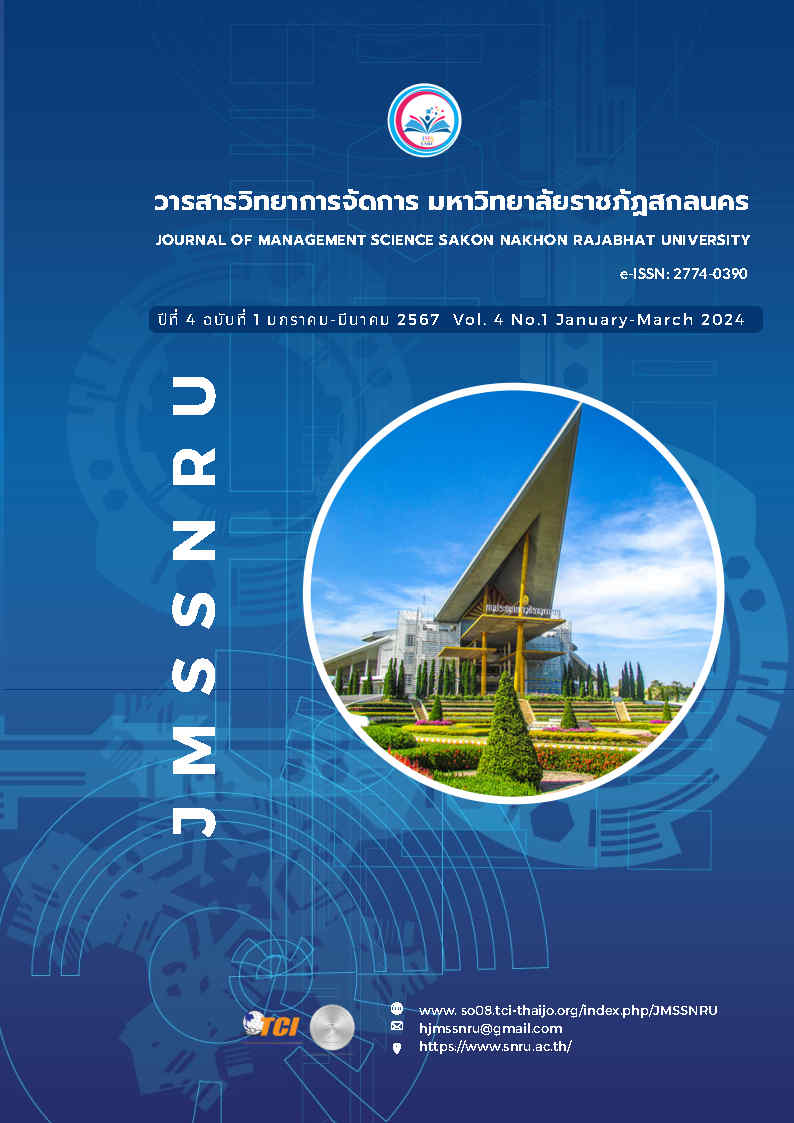INNOVATIVE LEADERSHIP OF SCHOOL ADMINISTRATORS IN PRIMARY EDUCATION SERVICE AREA OFFICE UDON THANI 3
Keywords:
Innovative leadership, School administratorAbstract
The purpose of this research article were to study the level of innovative leadership and methods for developing innovative leadership among administrators of school administrator under the Udon Thani Primary Educational Service Area Office 3. Sample group of 132 people by multistage sampling. Research tools included questionnaires and interviews. The value had a confidence level of 0.92. The consistency index was between 0.67 and 1.00. The researcher used frequency, percentage, mean, and standard deviation to analyze the data and content analysis. The researcher found that 1) the innovative leadership of school administrators in Udon Thani Primary Educational Service Area Office 3 was overall at a high level. When considering each aspect, it was found that the aspect of having a vision for change and the aspect of communication had the most average at the same level, second place was network building and working as a team. 2) Guidelines for developing effective innovative leadership among school administrators under the Udon Thani Primary Educational Service Area Office 3 included: administrators must have knowledge and understanding and courage to think and express thoughts. Executives must have innovative thinking, demonstrate leadership to drive school administrator creative ideas. There was a meeting to talk with personnel. The collaboration was established for building network, brainstorming and sharing idea for creating new innovation, seething plan and becoming a leader in innovation in school administration.
References
กุลชลี จงเจริญ. (2561). การบริหารทรัพยากรบุคคลทางการศึกษา. นนทบุรี: มหาวิทยาลัยสุโขทัยธรรมาธิราช.
ชูชาติ พ่วงสมจิตร์. (2561). แนวคิดเกี่ยวกับนวัตกรรมการบริหารการศึกษาและภาวะผู้นำในประมวลสาระชุดวิชานวัตกรรมการบริหารการศึกษาและภาวะผู้นำ หน่วยที่ 1-7. นนทบุรี: มหาวิทยาลัยสุโขทัยธรรมาธิราช.
ฐิตินันท์ นันทะศรี. (2563). การพัฒนาตัวบ่งชี้ภาวะผู้นำเชิงนวัตกรรมของผู้บริหารสถานศึกษา สังกัดสำนักงานเขตพื้นที่การศึกษาประถมศึกษาในภาคตะวันออกเฉียงเหนือ. วิทยานิพนธ์ปรัชญาดุษฎีบัณฑิต สาขาวิชาการบริหารและพัฒนาการศึกษา มหาวิทยาลัยราชภัฏสกลนคร.
ทินกร บัวชู. (2559). ภาวะผู้นำเชิงนวัตกรรมหัวหน้าหอผู้ป่วยโรงพยาบาลมหาวิทยาลัยของรัฐ. วิทยานิพนธ์ปริญญามหาบัณฑิต จุฬาลงกรณ์มหาวิทยาลัย.
ทิศนา แขมมณี. (2548). รูปแบบการเรียนการสอนทางเลือกที่หลากหลาย. กรุงเทพฯ: ด่านสุทธาการพิมพ์.
บุญชม ศรีสะอาด. (2560). การวิจัยเบื้องต้น. (พิมพ์ครั้งที่ 10). กรุงเทพฯ: สุวีริยสาส์น.
ปวีณา กันถิน. (2560). ภาวะผู้นำเชิงนวัตกรรมของผู้บริหารสถานศึกษาโรงเรียนประชารัฐ เขตพื้นที่การศึกษาประถมศึกษาเชียงใหม่ เขต 5. วิทยานิพนธ์ปริญญาศึกษาศาสตรมหาบัณฑิต สาขาวิชาการบริหารการศึกษา มหาวิทยาลัยเชียงใหม่.
ไพฑูรย์ สินลารัตน์. (2551). อุดมศึกษาโลกาภิวัฒน์: รายงานการดูงานและประชุมวิชาการต่างประเทศ. กรุงเทพฯ: จุฬาลงกรณ์มหาวิทยาลัย.
ภิรญา สายศิริสุข. (2561). ภาวะผู้นำเชิงนวัตกรรมของผู้บริหารในโรงเรียนมัธยมศึกษากลุ่มสหวิทยาเขตปัญจภาคี สังกัดสำนักงานเขตพื้นที่การศึกษามัธยมศึกษาเขต 4. บัณฑิตวิทยาลัย มหาวิทยาลัยเกษตรศาสตร์.
เวียงวิวรรธน์ ทำทูล. (2557). ภาวะผู้นำเชิงนวัตกรรมของผู้บริหารที่ส่งผลต่อองค์การขีดสมรรถนะสูงของโรงเรียนในสังกัดสำนักงานเขตพื้นที่การศึกษามัธยมศึกษา เขต 21. วารสารศึกษาศาสตร์มหาวิทยาลัยขอนแก่น, 37(3), 31-38.
สำนักงานเขตพื้นที่การศึกษาประถมศึกษากำแพงเพชร เขต 2. (2562). แผนพัฒนาการศึกษาประถมศึกษา:อัดสำเนา.
สำนักงานเขตพื้นที่การศึกษาประถมศึกษาอุดรธานีเขต 3. (2565). แผนปฏิบัติการประจำปี 2565: อัดสำเนา
สำนักงานคณะกรรมการพัฒนาการเศรษฐกิจและสังคมแห่งชาติ. (2558). ทิศทางแผนพัฒนาเศรษฐกิจสังคมแห่งชาติ ฉบับที่ 12 (2560-2564). นนทบุรี: รายงานสรุปผลการประชุมประจำปี 2558 ณ ศูนย์แสดงการประชุมอิมแพ็ค เมืองทองธานี จังหวัดนนทบุรี.
สุกัญญา แช่มช้อย. (2560). การบริหารสถานศึกษาในยุคดิจิทัล. พิษณุโลก: พิษณุโลกดอทคอม.
อนุสรา สุวรรณวงศ์. (2558). กลยุทธ์การบริหารเพื่อเสริมสร้างชุมชนแห่งการเรียนรู้ทางวิชาชีพสำหรับครูโรงเรียนเอกชน. วิทยานิพนธ์ปริญญาครุศาสตรดุษฎีบัณฑิต สาขาวิชาบริหารการศึกษา จุฬาลงกรณ์มหาวิทยาลัย.
อภินันท์ สิริรัตนจิตต์. (2562). การจัดการเรียนเน้นผู้เรียนเป็นสำคัญ. สงขลา: มหาวิทยาลัยหาดใหญ่.
อรอนงค์ โรจน์วัฒนบูลย์. (2553). การพัฒนาตัวแบบผู้นำเชิงนวัตกรรม. วิทยานิพนธ์ปริญญารัฐศาสตรดุษฎีบัณฑิต สาขาวิชาการบริหารการพัฒนา สถาบันบัณฑิตพัฒนบริหารศาสตร์.
Ailin, M. and Lindgren, P. (2008). Innovation Leadership in Danish SMEs. In Management of Innovation
and Technology, 2008. ICMIT 2008. 4th IEEE International Conference on 21-24 September 2008. pp. 98-103. Retrieved November 22, 2008, from IEEEXplore.
DuBrin, J. (1998). Leadership research finding: Practice and skills. Boston Houghton: Mifflin.
George, J. M., & Jones, G. R. (1996). Organizational behavior. (3rd ed). New Jersey: Prentice.
Gibson, J. L., Ivancevich, J. M., & Donnelly, J. H., Jr. (1997). Organizations, behavior structure processes. International Edition. United States of America: Irwin/McGraw-Hill.
Gliddon, D. G. (2006). Forecasting a competency model for innovation leaders using a modified Delphi
technique (Doctor dissertation of Philosophy). Pennsylvania: The Pennsylvania State University, Pennsylvania State.
Krejcie, R. V., & Morgan, D. W. (1970). Determining sample size for research activities. Educational and
Psychological Measurement, 30(3), 607-610.
McMillan, J. H. (2010). Participants, subjects, and sampling for quantitative designs. Upper Saddle River:
Pearson Education. organization behavior. 3rd ed. New York: McGraw-Hill.
Patel. (2012). Evolutionary crossroads in developmental biology. Development, 139(11), 2637-2638.
Porter-O’Grady, T., & Malloch, K. (2010). Innovation leadership: Creating the landscape of healthcare.
Sudbury, MA: Jones & Bartlett Learning.
Richard, I. A. (2009). Learning to teach. (9th ed). New York: Mc Graw-Hill.
Sen, A. & Erol Eren. (2012). Innovative Leadership for the twenty-first Century. Procedia - Social and
Behavioral Science, 41, 1-14.
Watts, M. (2002). The Content of Science: A Constructivist approach to its teaching and Learning. London:
The Felmer Press.
Downloads
Published
How to Cite
Issue
Section
License
Copyright (c) 2024 JOURNAL OF MANAGEMENT SCIENCE SAKON NAKHON RAJABHAT UNIVERSITY

This work is licensed under a Creative Commons Attribution-NonCommercial-ShareAlike 4.0 International License.
An article published in the Journal of Management Science. Sakon Nakhon Rajabhat University is the opinion, copyright and responsibility of the author of the work.






